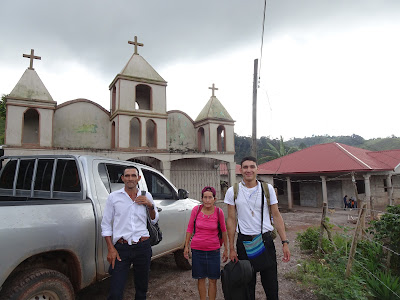Introductory note: I wanted to share two events that happened in the past few days. After I finished, I realized that they have to do with trying to be a servant, being images of Christ the Servant to the world.
Friday we had another training for Delegates of the Word, those who lead Sunday Celebrations in the absence of a priest so that people can come together and worship.
There were about ninety participants.
During the first part of the morning Padre German led the group in the retreat in the training manual for delegates.
After a break, I went aside with about eighteen women and men aspiring to become delegates. I am very encouraged that almost all are young. We need new blood in this important ministry.
Padre German asked me to work with them on basic church teaching and to start with examining them. Being a rebel, I decided to do the exam differently. They divided into groups. I asked a question which they were supposed to answer in the group and then we’d discuss it. This broke down when people began to just shout out a response and then we discussed the response.
But Padre German had the more difficult task with the delegates, some of whom have served for more than twenty-five years.
About a week ago the shared with me a concern about our annual celebration of Christ the King.
The tradition here is to get the whole parish together for Mass, often preceded by music and presentations, at times with a procession.
The feast of Christ the King is also the day to honor the Delegates of the Word.
Father was concerned that we give an image of Christ as a king, who lords it over others, dominates, has the last word, and is the supreme leader.
I too share this concern. When I discuss our baptism into Christ - Prophet, Priest, and King, I almost always say King/Servant.
A problem is that emphasizing this image of a worldly king on the Day of the Delegate of the Word may give the message that the delegate is to be the one who makes the decisions. I have even heard of a delegate who said something to the effect that the pastor rules in the parish, but he’s there; I rule here.
And some think clericalism is just something that has to do with priests. Clericalism runs deep in a patriarchal society and the notion of a privileged caste in the institutional church.
Don’t get me started. But, if you want to read more, I highly recommend Clericalism: The Death of Priesthood, by George B. Wilson, S.J.
Anyway, Padre German spent time trying to elicit from the delegates another way of looking at Christ the King – gentle, suffering, servant, humble.
We’ll be trying to emphasize these images for the feast.
Today, Sunday, I was supposed to pick up a group of people from Ames, Iowa, connected with the group importing coffee from an association in our parish. They are also connected with our sister parish, Saint Thomas Aquinas in Ames.
I was late leaving home for the airport (three and a half hours away) when I got a WhatsApp message that they had only twenty minutes to get to their second flight because of delays due to fog.
A few minutes later, there was another message – they had to rebook their flight.
So, I stayed in Plan Grande.
Tomorrow I’ll pick them up and be with them until next Sunday.
In the meantime, this morning, the pastor had called me to ask if I could assist at a funeral this afternoon.
I finally tracked down the people concerned and went for the two o’clock funeral.
I wasn’t as prepared as I usually want to be. I almost forget the books and my vestments and when I arrived there I realized I had only green vestments – for hope, as I explained to the people gathered at the family home.
The house was poor and up a path where only motorcycles could enter.
The woman who died, whose husband had died two years ago, was in her seventies. They had twelve children, only two of them women. Most were there, together with lots of kids and friends.
I was moved by the presence of kids around the table we used for an altar, just outside the tiny room where the coffin was. They were attentive as I put on my vestments, as I explained to them a little of what they meant.
The Celebration went well, and God provided me with what seemed like the right words. People seemed attentive.
I was also surprised and grateful that so many came forward for communion.
At the end of the celebration, I asked the adult children to come into the house for the final rites of sending – saying goodbye. La despedida.
Then they carried the coffin to a pick up to begin the procession to the cemetery.
What a privilege to be able to share with these people, to offer them a few words which I hope will give them courage and consolation.
This gives me joy.
Just a last note. People usually give the priest who comes for a Mass a donation to cover fuel. They ask me and I try to decline. But today one of the sons insisted on handing me a two hundred lempira note, which, I told him, I will put into the parish solidarity fund for the poor. He insisted. How can I refuse?






































